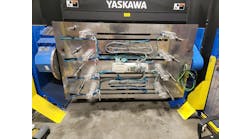→ What are the most important standards and regulations to be aware of when designing equipment that includes robots?
→ How has the explosion in end-effector options and availability affected the willingness to integrate robots?
→ What is it that makes the collaborative robot safe for human interaction?
→ Will the IIoT enable robots to modify engineering capacity at facilities to meet real-time production demands?
→ Collaborative robots eliminate the barrier between the working human and the robot, but what kinds of applications will actually benefit from collaborative robots?
→ What impact has non-vision sensing and robotics had on each other?
→ The growth of the robot market has seen an equally robust uptick in the machine vision market. Can you explain the correlation between the two, if there is one?
→ What technical advancements have made robots easier to integrate in equipment, cells or production lines?
→ What is being done to ensure the number of robot-related deaths remains as low as it’s been, if not lower?
Robotics and related services are changing industry worldwide. Spending has proliferated and will top $135 billion by 2019, according to research firm IDC, which measured the 2015 market at $71 billion in its Worldwide Commercial Robotics Spending Guide. Discrete manufacturing represents more than one-third of the spending on robotic systems, system hardware, software, robotics-related services and after-market robotics hardware.
"Robotics as a technology has really reached its tipping point," says John Santagate, research manager, supply chain at IDC Manufacturing Insights. "Robotic capabilities continue to expand while increasing investment in robot development is driving competition and helping to bring down the costs associated with robots.”
Roughly two-thirds of the spending is in the Asia/Pacific region, while Europe, the Middle East, and Africa (EMEA) notched expenditures of almost $15 billion in 2015, and the Americas spent almost $10 billion. Robotics spending will nearly double in Asia/Pacific over the 2015-2019 forecast period, making it the fastest growing region followed by the Americas, according to the IDC report.
With robotics playing such a pivotal role in the future of discrete manufacturing, we asked a seasoned panel of industry for their insights and predictions on the role of robots.
Meet the panel
David Arens is senior automation instructor, certified TUV functional safety engineer, at Bosch Rexroth Drives and Controls Division.
Alex Bonaire is robot product manager at Mitsubishi Electric Automation.
Melanie Cavalieri is product manager at Kollmorgen.
Allan Hottovy is business development manager at Telemecanique Sensors.
John Keinath is applications engineer at Sick.
Scott Mabie is general manager, Americas Division, at Universal Robots.
Henry Menke is marketing manager, object detection and position sensing, at Balluff.
Roberta Nelson Shea is global marketing manager for safety components at Rockwell Automation.
Garrett Place is product manager, imaging technologies, at ifm efector.
Shishir Rege is marketing manager, industrial networking, at Balluff.
Corey Ryan is manager—medical robotics, North America, at KUKA Robotics.
George Schuster is senior industry consultant for safety at Rockwell Automation.
Craig Souser is president of JLS Automation, a robotic packaging company in York, Pennsylvania.
Click the links below to see what the panel had to say
What are the most important standards and regulations to be aware of when designing equipment that includes robots?
How has the explosion in end-effector options and availability affected the willingness to integrate robots?
What is it that makes the collaborative robot safe for human interaction?
Will the IIoT enable robots to modify engineering capacity at facilities to meet real-time production demands?
Collaborative robots eliminate the barrier between the working human and the robot, but what kinds of applications will actually benefit from collaborative robots?
What impact has non-vision sensing and robotics had on each other?
The growth of the robot market has seen an equally robust uptick in the machine vision market. Can you explain the correlation between the two, if there is one?
What technical advancements have made robots easier to integrate in equipment, cells or production lines?
What is being done to ensure the number of robot-related deaths remains as low as it’s been, if not lower?
Homepage main image courtesy of Stuart Miles at FreeDigitalPhotos.net





















